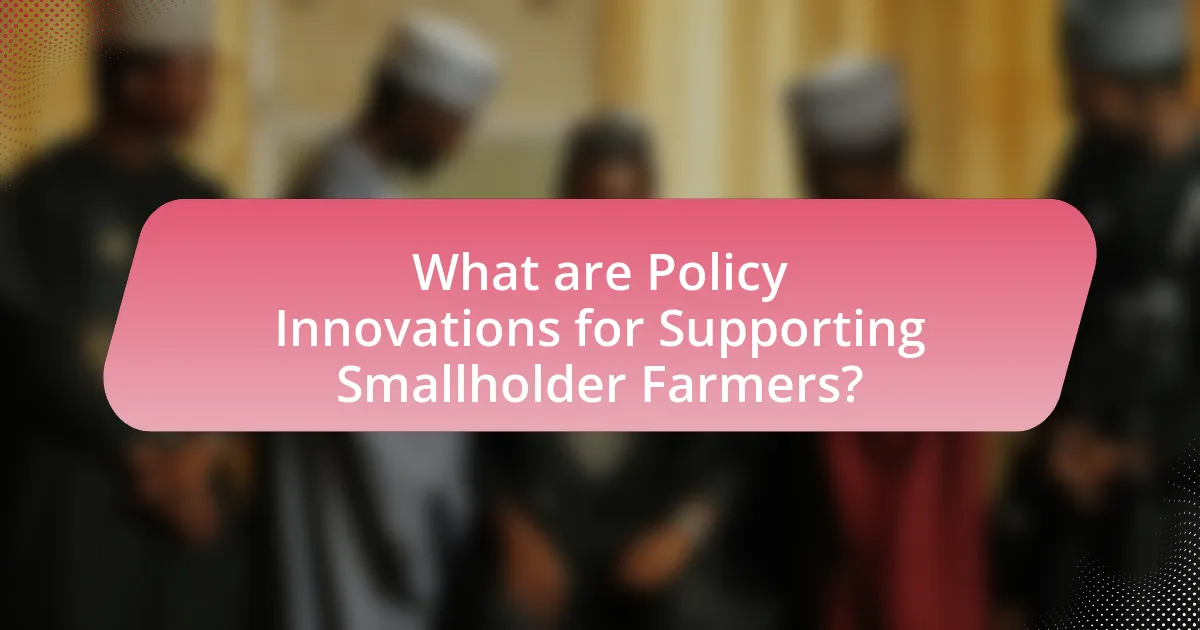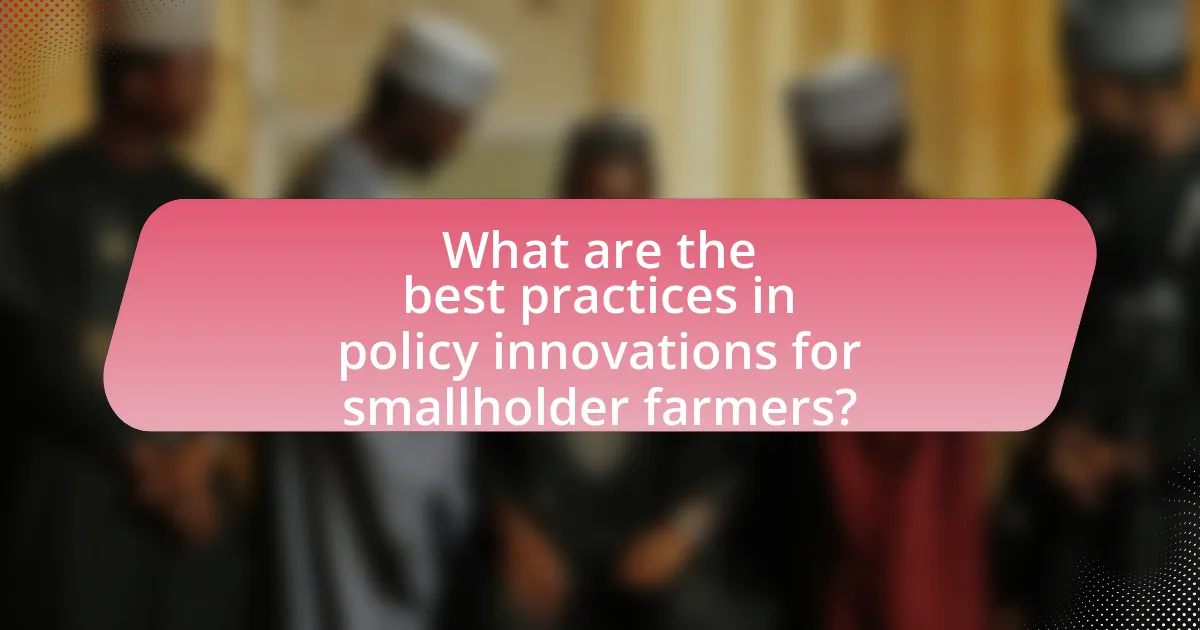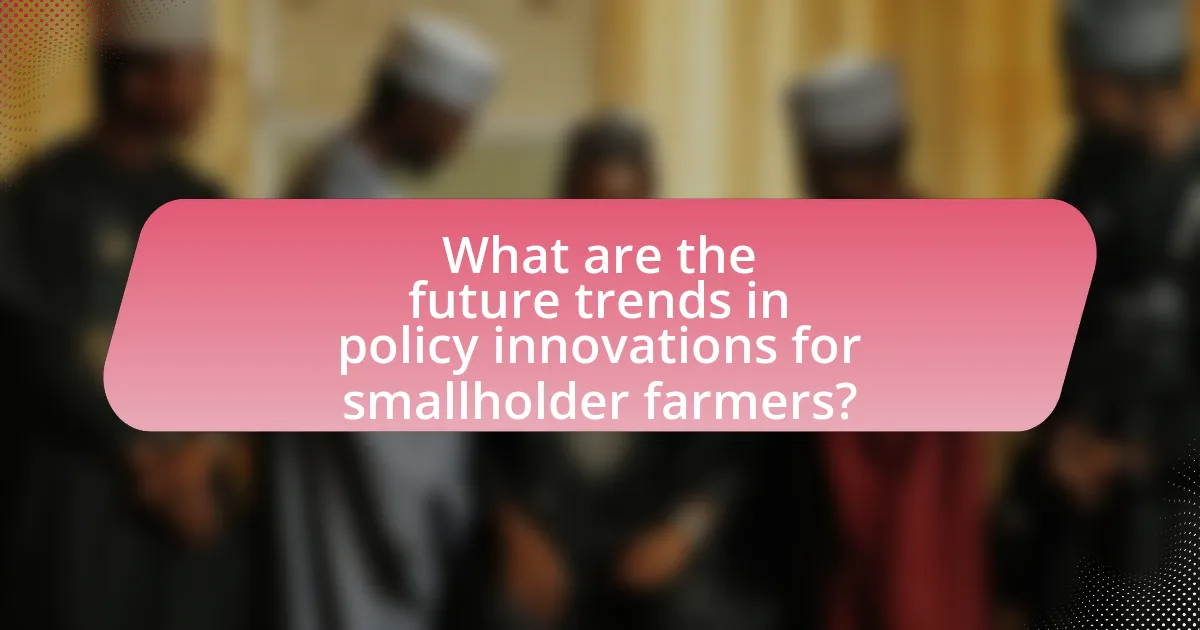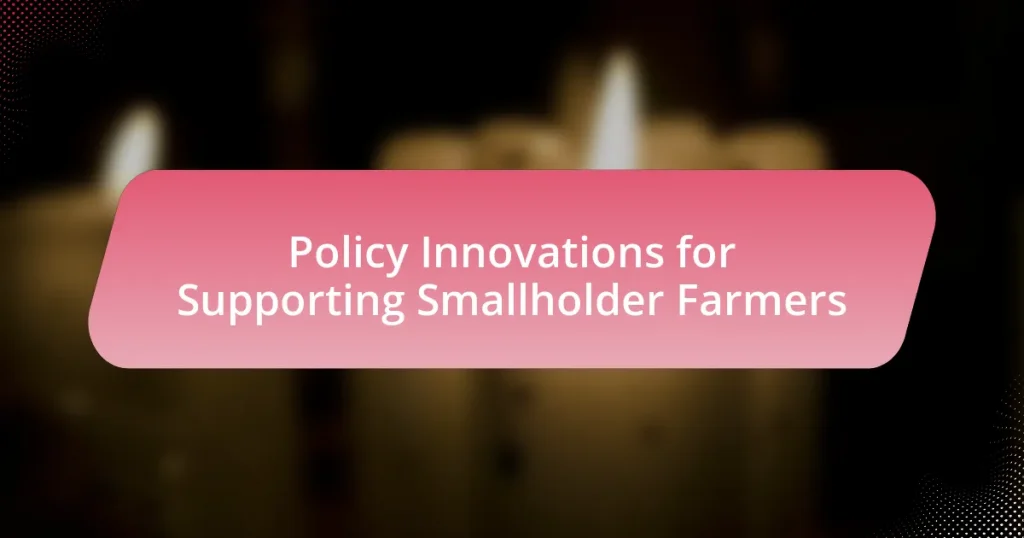Policy innovations for supporting smallholder farmers encompass various initiatives aimed at enhancing their productivity and livelihoods. These include access to credit, improved agricultural technology, and better market access, addressing challenges such as limited resources and vulnerability to climate change. The article discusses the impact of these innovations on smallholder farmers, highlighting specific challenges they face, the role of technology, and successful policy examples from different regions. It also examines the importance of stakeholder collaboration, funding mechanisms, and metrics for evaluating policy effectiveness, ultimately emphasizing the necessity of tailored approaches to empower smallholder farmers and ensure food security.

What are Policy Innovations for Supporting Smallholder Farmers?
Policy innovations for supporting smallholder farmers include initiatives such as access to credit, improved agricultural technology, and enhanced market access. These innovations aim to address the challenges faced by smallholder farmers, who often lack resources and support. For instance, microfinance programs have been shown to increase investment in farming practices, leading to higher yields and income. Additionally, the introduction of mobile technology for market information allows farmers to make informed decisions, improving their bargaining power. Evidence from the Food and Agriculture Organization indicates that such policy innovations can significantly enhance productivity and sustainability in smallholder farming systems.
How do these policy innovations impact smallholder farmers?
Policy innovations significantly enhance the livelihoods of smallholder farmers by improving access to resources, markets, and technology. These innovations often include financial support mechanisms, such as microloans and subsidies, which enable farmers to invest in better seeds and equipment. For instance, a study by the Food and Agriculture Organization (FAO) found that targeted subsidies can increase crop yields by up to 30%, directly benefiting smallholder farmers. Additionally, policies that promote cooperative farming and collective marketing help smallholders gain better prices for their produce, thereby increasing their income and economic stability. Overall, these policy innovations create a more supportive environment for smallholder farmers, leading to improved productivity and sustainability in agriculture.
What specific challenges do smallholder farmers face that these policies address?
Smallholder farmers face challenges such as limited access to credit, inadequate infrastructure, and vulnerability to climate change, which these policies aim to address. Specifically, policies often provide financial support mechanisms that enhance access to loans, enabling farmers to invest in better technologies and practices. Additionally, infrastructure improvements, such as better roads and storage facilities, are implemented to reduce post-harvest losses and improve market access. Furthermore, climate adaptation strategies are included in these policies to help farmers mitigate the impacts of extreme weather events, thereby increasing their resilience and productivity.
How do these innovations enhance the livelihoods of smallholder farmers?
Innovations enhance the livelihoods of smallholder farmers by increasing productivity, improving access to markets, and providing better financial services. For instance, the introduction of drought-resistant crop varieties has been shown to boost yields by up to 30%, allowing farmers to produce more food and generate higher income. Additionally, digital platforms that connect farmers directly to consumers reduce reliance on intermediaries, enabling farmers to receive fair prices for their products. Furthermore, access to microfinance and insurance products helps farmers manage risks and invest in their farms, leading to sustainable growth. These innovations collectively contribute to improved food security and economic stability for smallholder farmers.
Why are policy innovations necessary for smallholder farmers?
Policy innovations are necessary for smallholder farmers to enhance their productivity and resilience against challenges such as climate change and market fluctuations. These farmers, who represent about 80% of the world’s food supply, often lack access to resources, technology, and financial services. Innovative policies can provide targeted support, such as improved access to credit, training programs, and sustainable agricultural practices. For instance, the Food and Agriculture Organization (FAO) reports that policy frameworks promoting sustainable practices can increase yields by up to 30% in smallholder farming systems. Therefore, effective policy innovations are crucial for empowering smallholder farmers and ensuring food security.
What role do smallholder farmers play in the agricultural sector?
Smallholder farmers are crucial to the agricultural sector as they produce a significant portion of the world’s food supply, estimated at around 70%. These farmers, who typically operate on small plots of land, contribute to local economies, enhance food security, and promote biodiversity through diverse cropping systems. Their role is particularly vital in developing countries, where they often represent the majority of the agricultural workforce and are key players in rural development. According to the Food and Agriculture Organization, smallholder farms account for about 80% of all farms globally, underscoring their importance in sustaining livelihoods and fostering economic growth in rural areas.
How do policy innovations contribute to food security and sustainability?
Policy innovations enhance food security and sustainability by creating frameworks that support smallholder farmers through improved access to resources, technology, and markets. These innovations often include subsidies, training programs, and infrastructure development, which empower farmers to increase productivity and resilience against climate change. For instance, the Food and Agriculture Organization reported that targeted policies can lead to a 20% increase in crop yields among smallholder farmers, directly contributing to food security. Additionally, sustainable practices promoted through policy innovations, such as agroecology and organic farming, help maintain biodiversity and soil health, further ensuring long-term food sustainability.
What types of policy innovations exist for supporting smallholder farmers?
Policy innovations for supporting smallholder farmers include access to credit, insurance schemes, and market linkages. Access to credit allows smallholder farmers to invest in necessary inputs, with programs like microfinance specifically designed for agricultural needs. Insurance schemes, such as weather-indexed insurance, protect farmers against climate-related risks, enhancing their resilience. Market linkages facilitate direct connections between farmers and consumers or retailers, improving income stability and reducing reliance on intermediaries. These innovations are crucial for enhancing productivity and sustainability in smallholder farming systems.
What are the key features of successful policy innovations?
Successful policy innovations are characterized by adaptability, stakeholder engagement, evidence-based decision-making, and scalability. Adaptability allows policies to evolve in response to changing circumstances and needs, ensuring relevance over time. Stakeholder engagement involves collaboration with affected communities, which fosters ownership and increases the likelihood of successful implementation. Evidence-based decision-making relies on data and research to inform policy design, enhancing effectiveness and efficiency. Scalability ensures that successful innovations can be expanded or replicated in different contexts, maximizing their impact. For instance, the implementation of mobile technology in agricultural practices has shown adaptability and scalability, significantly improving smallholder farmers’ access to information and markets.
How do these innovations vary across different regions or countries?
Innovations in policies supporting smallholder farmers vary significantly across regions and countries due to differing agricultural practices, economic conditions, and government priorities. For instance, in Sub-Saharan Africa, policies often focus on improving access to credit and markets, as evidenced by initiatives like the African Development Bank’s Feed Africa strategy, which aims to enhance food security and agricultural productivity. In contrast, countries in Southeast Asia, such as Vietnam, emphasize technology adoption and training programs to boost productivity, supported by government programs like the Vietnam Agricultural Restructuring Plan. Additionally, in Latin America, countries like Brazil implement social protection policies, such as the Bolsa Família program, which integrates agricultural support with social welfare to improve the livelihoods of smallholder farmers. These regional differences highlight how local contexts shape the design and implementation of policy innovations for smallholder farmers.
How can stakeholders collaborate to enhance policy innovations?
Stakeholders can collaborate to enhance policy innovations by establishing multi-sector partnerships that leverage diverse expertise and resources. For instance, agricultural organizations, government agencies, and academic institutions can work together to share data, research findings, and best practices, which leads to more informed policy decisions. A study by the Food and Agriculture Organization highlights that collaborative frameworks, such as public-private partnerships, have successfully improved agricultural policies in various countries by integrating local knowledge and addressing specific needs of smallholder farmers. This collaborative approach not only fosters innovation but also ensures that policies are more relevant and effective in supporting smallholder farmers.
What are the potential barriers to implementing these policy innovations?
The potential barriers to implementing policy innovations for supporting smallholder farmers include lack of funding, insufficient infrastructure, and resistance from established agricultural stakeholders. Lack of funding can hinder the development and execution of innovative programs, as financial resources are essential for training, technology adoption, and infrastructure improvements. Insufficient infrastructure, such as poor transportation and storage facilities, limits farmers’ access to markets and resources, making it difficult to implement new policies effectively. Additionally, resistance from established agricultural stakeholders, including larger agribusinesses and traditional farming practices, can obstruct the adoption of innovative policies, as these groups may perceive changes as threats to their interests. These barriers collectively impede the successful implementation of policies aimed at enhancing the livelihoods of smallholder farmers.

What are the best practices in policy innovations for smallholder farmers?
Best practices in policy innovations for smallholder farmers include implementing inclusive agricultural policies, enhancing access to credit and financial services, and promoting sustainable agricultural practices. Inclusive agricultural policies ensure that smallholder farmers are represented in decision-making processes, which can lead to tailored support that meets their specific needs. Access to credit and financial services is crucial, as it allows farmers to invest in better seeds, technology, and equipment; for instance, the World Bank reports that access to finance can increase agricultural productivity by up to 30%. Promoting sustainable agricultural practices, such as agroecology and organic farming, not only improves food security but also enhances resilience to climate change, as evidenced by studies showing that sustainable practices can increase yields by 20-50% in vulnerable regions.
How can governments effectively design policies for smallholder farmers?
Governments can effectively design policies for smallholder farmers by implementing targeted support programs that address their specific needs, such as access to credit, technology, and markets. For instance, policies that provide microfinance options enable smallholder farmers to invest in better seeds and equipment, which can increase productivity. According to the Food and Agriculture Organization, access to financial services can lead to a 30% increase in agricultural productivity among smallholder farmers. Additionally, establishing cooperative structures allows farmers to pool resources and negotiate better prices, enhancing their market position. Evidence from various countries shows that such cooperative models can improve income stability and reduce vulnerability to market fluctuations.
What data and research are essential for informed policy-making?
Informed policy-making requires comprehensive data on agricultural productivity, economic conditions, and social factors affecting smallholder farmers. This data includes quantitative metrics such as crop yields, income levels, and access to resources, which help policymakers understand the challenges and opportunities within the agricultural sector. Research studies, such as “The Role of Smallholder Farmers in Food Security” by the Food and Agriculture Organization, provide evidence on the impact of smallholder farming on food systems and economic stability. Additionally, qualitative research that captures the experiences and needs of farmers is crucial for developing targeted interventions. This combination of quantitative and qualitative data ensures that policies are grounded in reality and effectively address the specific needs of smallholder farmers.
How can stakeholder engagement improve policy outcomes?
Stakeholder engagement can improve policy outcomes by ensuring that diverse perspectives and expertise are incorporated into the decision-making process. This inclusion leads to more informed policies that address the actual needs and challenges faced by smallholder farmers. For instance, research by the Food and Agriculture Organization (FAO) highlights that participatory approaches in policy formulation can enhance the relevance and effectiveness of agricultural policies, resulting in better resource allocation and increased farmer satisfaction. Engaging stakeholders also fosters collaboration, builds trust, and encourages shared ownership of policies, which can lead to more sustainable and impactful outcomes in supporting smallholder farmers.
What role do NGOs and international organizations play in supporting these policies?
NGOs and international organizations play a crucial role in supporting policies aimed at enhancing the livelihoods of smallholder farmers. They provide technical assistance, funding, and advocacy to implement and promote effective agricultural practices and policies. For instance, organizations like the Food and Agriculture Organization (FAO) and Oxfam have been instrumental in developing programs that improve access to resources, training, and markets for smallholder farmers, thereby increasing their productivity and income. Additionally, these entities often facilitate partnerships between governments and local communities, ensuring that policies are inclusive and tailored to the specific needs of smallholder farmers. Their involvement is supported by evidence showing that targeted interventions can lead to significant improvements in food security and economic stability for these farmers.
How can partnerships between governments and NGOs enhance policy effectiveness?
Partnerships between governments and NGOs can enhance policy effectiveness by leveraging the unique strengths of each entity to address complex social issues. Governments provide regulatory frameworks and resources, while NGOs offer grassroots insights and community engagement. For instance, a study by the World Bank in 2020 highlighted that collaborative initiatives in agricultural policy led to a 30% increase in smallholder farmer productivity in regions where NGOs facilitated training and access to markets. This synergy allows for more tailored and responsive policies that meet the actual needs of communities, ultimately leading to improved outcomes in areas such as food security and economic development.
What funding mechanisms are available for policy innovations?
Funding mechanisms available for policy innovations include government grants, private sector investments, public-private partnerships, and international development aid. Government grants often support pilot projects and research initiatives aimed at enhancing agricultural practices for smallholder farmers. Private sector investments can provide capital for innovative technologies and practices that improve productivity and sustainability. Public-private partnerships leverage resources and expertise from both sectors to implement scalable solutions. International development aid, from organizations such as the World Bank or the United Nations, offers financial support for projects that align with broader development goals, particularly in agriculture and rural development. These mechanisms collectively facilitate the implementation of innovative policies that support smallholder farmers.

What are the future trends in policy innovations for smallholder farmers?
Future trends in policy innovations for smallholder farmers include the integration of digital technologies, enhanced access to finance, and the promotion of sustainable agricultural practices. Digital technologies, such as mobile apps and precision agriculture tools, are increasingly being adopted to improve productivity and market access. For instance, the use of mobile platforms for information dissemination has been shown to increase farmers’ income by up to 30%. Enhanced access to finance through microloans and insurance products tailored for smallholders is also gaining traction, with initiatives like the Agricultural Finance Initiative providing critical support. Furthermore, policies promoting sustainable practices, such as agroecology and climate-smart agriculture, are being prioritized to ensure long-term viability and resilience against climate change impacts. These trends reflect a shift towards more inclusive and adaptive policy frameworks that address the unique challenges faced by smallholder farmers.
How is technology influencing policy innovations for smallholder farmers?
Technology is significantly influencing policy innovations for smallholder farmers by enabling data-driven decision-making and enhancing access to resources. For instance, mobile applications provide farmers with real-time weather updates, market prices, and agricultural best practices, which inform policy frameworks aimed at improving productivity and sustainability. Additionally, technologies such as blockchain enhance transparency in supply chains, prompting policies that support fair trade and equitable pricing for smallholder farmers. Research from the Food and Agriculture Organization indicates that digital tools can increase agricultural productivity by up to 30%, demonstrating the tangible impact of technology on policy development in this sector.
What technological advancements are being integrated into agricultural policies?
Technological advancements integrated into agricultural policies include precision agriculture, digital farming tools, and biotechnology. Precision agriculture utilizes GPS and IoT sensors to optimize field-level management regarding crop farming, which enhances productivity and resource efficiency. Digital farming tools, such as mobile applications and data analytics platforms, facilitate real-time decision-making for farmers, improving yield and reducing costs. Biotechnology advancements, including genetically modified organisms (GMOs) and CRISPR technology, enable the development of crops that are more resilient to pests and climate change. These advancements are supported by policies aimed at increasing food security and sustainability, as evidenced by initiatives like the European Union’s Farm to Fork Strategy, which emphasizes innovation in agriculture to achieve environmental goals.
How can digital platforms support smallholder farmers through policy innovations?
Digital platforms can support smallholder farmers through policy innovations by facilitating access to information, markets, and financial services. These platforms enable farmers to receive real-time data on weather, prices, and best practices, which enhances decision-making and productivity. For instance, the use of mobile applications has been shown to increase crop yields by up to 30% by providing timely agricultural advice. Furthermore, digital platforms can connect farmers directly to consumers and suppliers, reducing transaction costs and increasing profit margins. Research indicates that digital financial services can improve access to credit for smallholder farmers, with studies showing that mobile banking can increase loan uptake by 20%. These innovations create an ecosystem that empowers smallholder farmers, ultimately leading to improved food security and economic stability.
What lessons can be learned from successful policy innovations globally?
Successful policy innovations globally demonstrate the importance of context-specific solutions tailored to local needs. For instance, Brazil’s Bolsa Família program effectively reduced poverty by providing conditional cash transfers, which incentivized education and healthcare access among low-income families. This approach highlights the necessity of aligning policy objectives with the socio-economic realities of the target population. Additionally, the integration of stakeholder engagement in policy design, as seen in India’s National Rural Livelihoods Mission, fosters community ownership and enhances implementation success. Evidence from these cases shows that adaptable, inclusive, and participatory frameworks lead to more effective policy outcomes for smallholder farmers.
Which countries have implemented effective policies for smallholder farmers?
Countries that have implemented effective policies for smallholder farmers include Brazil, India, and Ethiopia. Brazil’s Zero Hunger Program has significantly improved food security and income for smallholder farmers by providing direct financial support and access to markets. In India, the National Policy for Farmers aims to enhance the income of smallholders through various initiatives, including price support and crop insurance. Ethiopia’s Agricultural Transformation Agenda focuses on improving agricultural productivity and market access for smallholder farmers, resulting in increased yields and income. These policies demonstrate a commitment to supporting smallholder farmers through targeted interventions and resources.
What metrics can be used to evaluate the success of these policies?
Metrics that can be used to evaluate the success of policies supporting smallholder farmers include agricultural productivity, income levels, access to markets, and food security indicators. Agricultural productivity can be measured through crop yields and the number of crops produced per hectare, which directly reflects the effectiveness of farming policies. Income levels can be assessed by analyzing changes in farmers’ earnings before and after policy implementation, providing insight into economic impact. Access to markets can be evaluated through the percentage of farmers able to sell their products at fair prices, indicating the success of market access initiatives. Food security indicators, such as the prevalence of undernourishment or food availability, can also serve as critical metrics to determine the overall effectiveness of these policies in improving the livelihoods of smallholder farmers.
What practical steps can smallholder farmers take to benefit from policy innovations?
Smallholder farmers can benefit from policy innovations by actively engaging in local agricultural policy discussions and advocating for their needs. By participating in farmer cooperatives or associations, they can collectively voice their concerns and influence policy decisions that affect their livelihoods. Research shows that organized groups of farmers have successfully lobbied for favorable policies, such as access to credit and subsidies, which enhance their productivity and income. Additionally, smallholder farmers should stay informed about new policies and programs through workshops and training sessions, enabling them to take advantage of available resources and support. This proactive approach ensures that they can adapt to changing agricultural policies and leverage innovations that improve their farming practices and economic outcomes.















